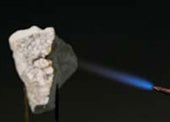Gray Matter: How to make a lamp out of lime
Create a superbright spotlight just like the stagehands of old: with a blowtorch and a hunk of quicklime.

Phones haven’t had dials since the Reagan administration, but you still “dial” them. Clocks have been digital for a generation, but time still “ticks” away. And fame hasn’t involved calcium oxide for over 100 years, but when you’re famous, you’re still “in the limelight.”
- Project: retro DIY spotlight
- Cost: $10
- Time: 30 minutes
- Difficulty: safe | | | | | crazy (Editor’s note: 4/5)
Throughout much of the 19th century, gaslights lit theater stages, while limelights cast a concentrated beam of light on the star. The source of the glow was white-hot quicklime, or calcium oxide (which I order from fishersci.com). Quicklime is much more corrosive than common garden lime—among other things, it’s used for disintegrating dead bodies in disaster zones to prevent the spread of infection.
Achtung! Theodore Gray is a scientist trained in lab safety procedures. Do not attempt this experiment at home. For more information on Gray’s scientific pursuits, visit his website.
Limelight sounds exotic, but it’s just a form of incandescent lighting. In a standard bulb, electric current heats a tungsten wire until it glows brightly. In limelight, it’s an oxy-hydrogen flame heating a chunk of quicklime. Different heat source, same idea. It glows for the same reason anything hot glows: When heated, atoms vibrate rapidly, and vibrating atoms emit light. Other compounds, such as thorium oxide, would also work, but lime is cheaper and has the distinct advantage of not being radioactive. And the chunk I used showed no signs of wear after half an hour at 4,300 degrees Fahrenheit.
You can still buy a flame-heated light at Walmart today. Propane camping lanterns use a gas flame to heat a mesh (called a mantle) of rare-earth oxides to the point that it glows. I even broke open a modern bulb and held a propane torch to the tungsten filament. Sure enough, it shone just like it was heated with electricity.
Practical? No. But with time ticking away on the oil supply, it’s good to know that when the electricity runs dry and we can’t dial our cellphones anymore, we can still use our old light bulbs—if we’re cooking with gas.

This story has been updated. It was originally published in the September 2007 issue of Popular Science magazine.